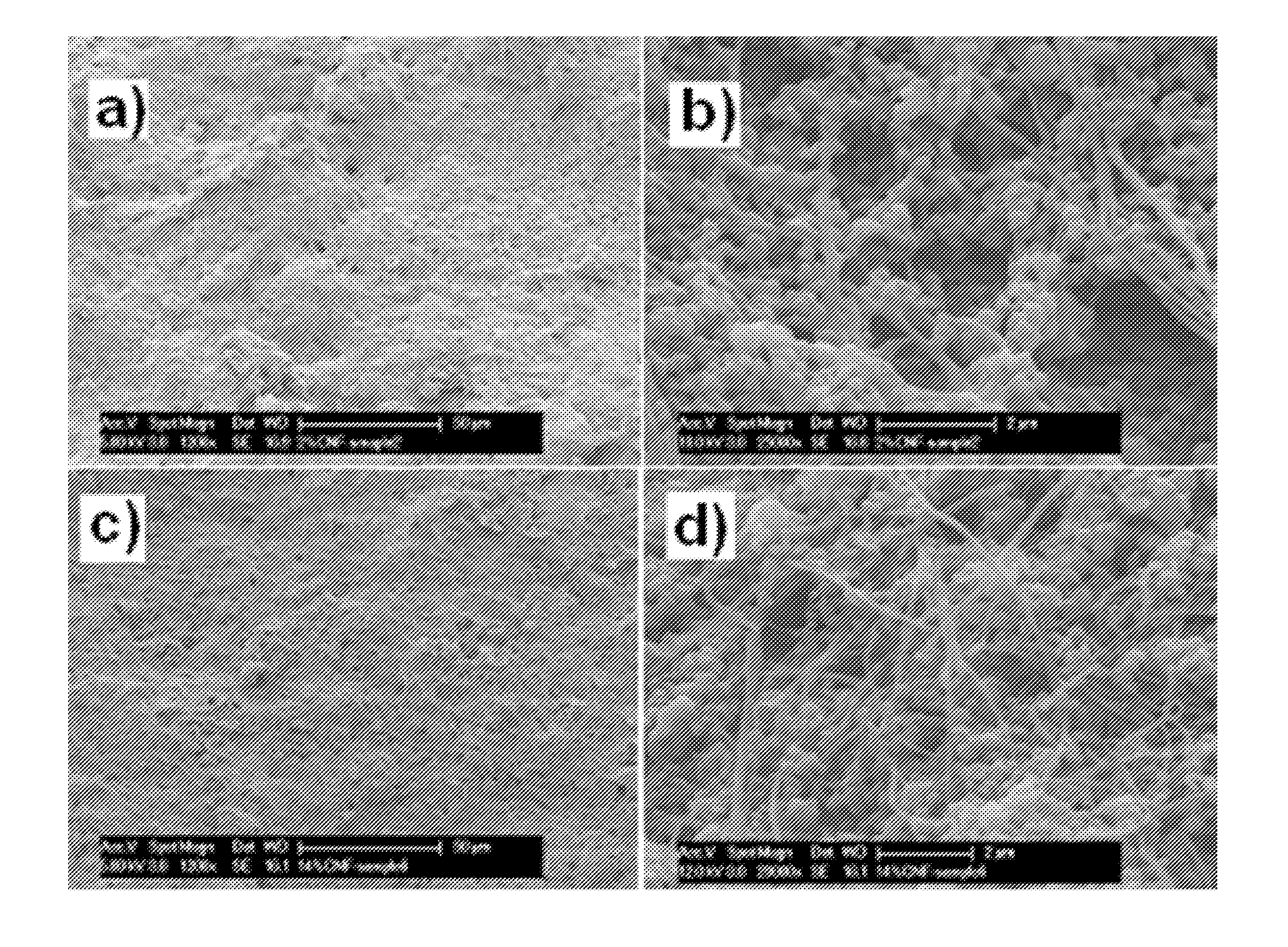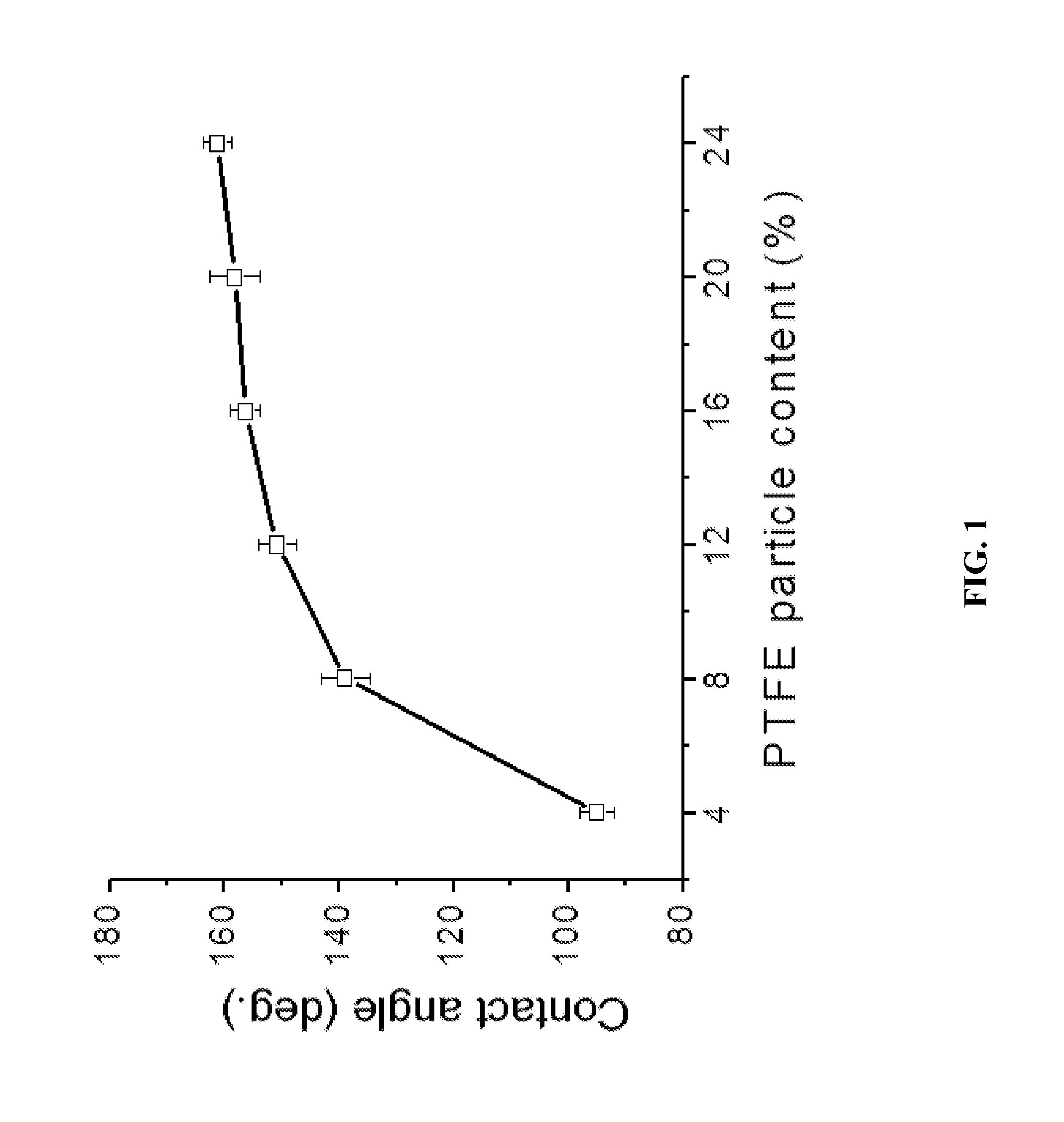Liquid-repellent, large-area, electrically-conducting polymer composite coatings
- Summary
- Abstract
- Description
- Claims
- Application Information
AI Technical Summary
Problems solved by technology
Method used
Image
Examples
example 1
[0062]Embodiments of the invention comprise preparation of polymeric composite compositions comprising selected loadings of fillers. In Example 1, 60 / 40 weight percent (wt. %) solution blends of PVDF (530 kDa; Sigma-Aldrich, USA) and PMMA (996 kDa; Sigma-Aldrich, USA) were prepared by mixing 20 wt. % solution of PVDF in Dimethylformamide (DMF) with 10 wt. % solution of PMMA in acetone. Six polymeric composite compositions comprising specific loadings of CNFs having an average fiber diameter of 100 nm (PR24XT-HHT Pyrograf III; Applied Sciences Inc., USA) were prepared, having weight ratios of PVDF / PMMA polymer blend solution to CNF of 1:0.068, 1:0.138, 1:0.281, 1:0.587, 1:0.921 and 1:1.1. The CNFs were free of CVD carbon, with highly graphitized structures developed by high temperature treatment, resulting in higher electrical and thermal conductivity compared to as-grown fibers [26]. In each composition, submicron PTFE particles having an average diameter of 260 nm±54.2 nm (Sigma-Al...
example 2
[0065]The optimal amount of PTFE filler particles in PVDF / PMMA polymer matrices for attaining superhydrophobicity was determined through wettability tests on dried coatings without CNFs. A 60 / 40 PVDF / PMMA blend was the binder, and the corresponding PTFE / (PVDF+PMMA) weight ratio varied in the range of 1:1.44-8.64. FIG. 1 shows that for films comprising a PTFE particle content above 16 wt. %, water sessile contact angles exceeded 150°, indicating this as the minimum concentration for superhydrophobic behavior. For 16 wt. % PTFE loading, PTFE / (PVDF+PMMA) has a weight ratio of 1:5.76, and the dried coating is superhydrophobic, more specifically exhibiting a sessile water contact angle of 158°. This minimum PTFE / (PVDF+PMMA) weight ratio to achieve superhydrophobicity of 1:5.76 was kept fixed when preparing composite coatings containing CNFs.
[0066]The amount of PTFE particles suitable for the polymer composite composition is expressed either as a weight percent of the entire composition o...
example 3
[0067]Hydrophobicity and conductivity were tested for polymer composite films according to embodiments of the invention. Water droplet contact and roll-off angle measurements were performed using an in house goniometer-type optical setup described previously [24]. FIG. 2 shows the results of wettability tests and conductivity measurements for dried composite coatings with different CNF loadings expressed in terms of CNF / polymer weight ratios. As shown in FIG. 2, static water contact angles for all CNF loadings remained above 150°. At the maximum CNF loading of 1.1, the measured contact angle reached a value of 158°. As noted in Example 2 above, the corresponding contact angle for CNF-free coating was 158°, which indicates that liquid-repellency is not contingent on the presence of CNFs. Self-cleaning is promoted by low roll-off angles, when the water droplet carries impurities off the tilted surface. FIG. 3 shows that water droplet roll-off angles for all CNF loadings remained close...
PUM
| Property | Measurement | Unit |
|---|---|---|
| Temperature | aaaaa | aaaaa |
| Fraction | aaaaa | aaaaa |
| Thickness | aaaaa | aaaaa |
Abstract
Description
Claims
Application Information
 Login to View More
Login to View More - R&D
- Intellectual Property
- Life Sciences
- Materials
- Tech Scout
- Unparalleled Data Quality
- Higher Quality Content
- 60% Fewer Hallucinations
Browse by: Latest US Patents, China's latest patents, Technical Efficacy Thesaurus, Application Domain, Technology Topic, Popular Technical Reports.
© 2025 PatSnap. All rights reserved.Legal|Privacy policy|Modern Slavery Act Transparency Statement|Sitemap|About US| Contact US: help@patsnap.com



